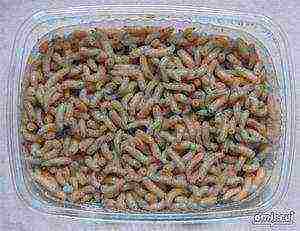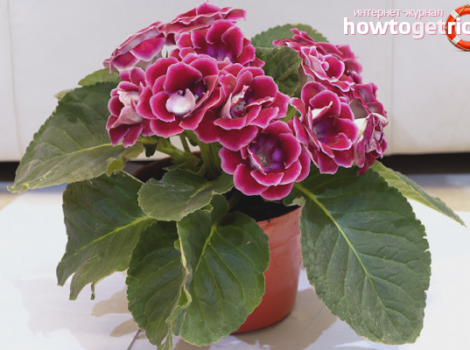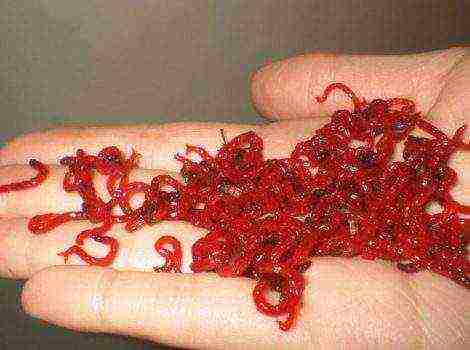Content
There are more than enough mushroom lovers in our country! Only for a hike in the forest for a "quiet hunt" you need the accompanying weather and certain climatic conditions. Not everyone will think about growing mushrooms at home, and even almost on an industrial scale. Most consider this to be fantastic. However, everything is real. And we will tell you how to grow mushrooms in a greenhouse or at home.
What mushrooms can be grown at home
The very idea of growing mushrooms at home poses a choice of a specific species. All varieties suitable for home breeding do not need special material costs or additional efforts. The only exceptions are champignons, but an experienced gardener will cope with this problem too. The choice must be made, first of all, based on the desired profit. All varieties of mushrooms suitable for growing at home can be classified into two main types:
- woody;
- soil.
The first include the well-known shiitake mushrooms, oyster mushrooms, and winter mushrooms. But to the second - no less popular mushrooms and ringlets. Even with small areas, the harvest can be excellent. That is why these varieties are recommended for growing on an industrial scale.
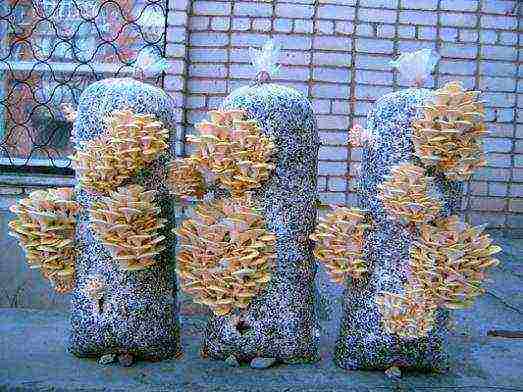 Growing oyster mushrooms at home on the balcony
Growing oyster mushrooms at home on the balcony
Growing technology for beginners
The bulk of the time it takes to grow mushrooms is spent creating mycelium. However, the advice of experienced mushroom growers suggests that it is better to grow this material on your own. After all, even the best and trusted suppliers fail from time to time. Mycelium can be grown in two ways:
- in the grain substrate;
- on wooden sticks.
The choice depends on what kind of mushrooms you plan to grow.
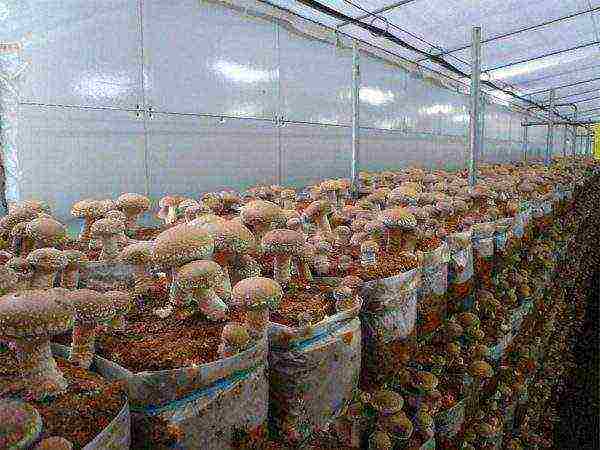 Growing mushrooms on a nutritious substrate
Growing mushrooms on a nutritious substrate
Breeding mycelium
The mycelium is grown in a specific substrate. It is recommended to take care that its chemical and mineral composition is as similar as possible to that in which mushrooms grow naturally. The composition of this medium must be selected again, depending on the type of mushrooms grown.
For example, shiitake mushrooms feel more comfortable in wood, mushrooms - in compost, but oyster mushrooms prefer straw. With proper care, chopped straw and sawdust can yield any of these types of mushrooms. However, the substrate must be of high quality. This is ensured by its dryness, absence of mold, as well as unpleasant odors and foreign impurities.
Wheat straw is best suited for growing mushrooms. You can also use rye or barley. Oyster mushrooms are allowed to be propagated in sunflower husks. However, only fresh material should be used, since pathogenic bacteria can grow excellently in old ones.
The mycelium is the backbone of a large number of germinated fungal spores. As soon as this base is placed in the substrate, the process of active growth begins. Initially, only the appearance of thin filaments can be observed, which eventually turn into edible mushrooms.
 Mushroom mycelium
Mushroom mycelium
It is worth purchasing high-quality planting material only in specialized stores. Priority should be given to wood containing viable fungal spores. They will be more resistant to disease. Not planted from grain mycelium. Ordinary mushroom spores can also be purchased. Only in this case it will take more time and effort to grow your crop. The procedure will resemble the cultivation of any crop from seed. It is better for beginners to avoid this method.
To obtain the maximum yield, it is necessary that the mycelium spreads as thoroughly as possible in the compost. To do this, you need to keep the planting warm. They can be heated using a special electric pillow. Heat is needed only during the incubation period. Once the mushrooms are in the growing phase, it is best to keep them cool. A glazed and insulated balcony is well suited for this.
When growing mushrooms in residential premises, the maturation phase must be avoided. Otherwise, the spores released into the air can provoke allergic reactions and even asthma.
As a rule, seedlings appear in the third week after planting the mycelium. Readiness for harvesting is determined by the hat. You need to cut off ready-made mushrooms only with a knife, so as not to injure those that are still in the soil and are just preparing to give a crop. The ready-made collection can be used both immediately and after preliminary freezing.
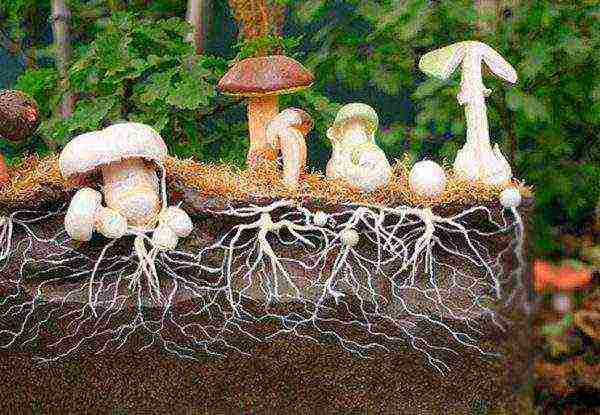 Sectional diagram of mushroom growth from mycelium
Sectional diagram of mushroom growth from mycelium
Other ways to grow mushrooms at home
In addition to the main ones, there are also additional ways of growing mushrooms. True, they do not bring such a large-scale result and are used mainly by children as experiments. For example, some types of mushrooms can be grown on logs. For this logs up to half a meter long are cut from hardwood. This must be done at least 2 weeks before settling with mycelium.
In the resulting workpiece, holes are made in a checkerboard pattern at a distance of 10 cm. After that, the sticks with mycelium must be sealed. A hammer can be used for this procedure.
Before starting work, you must disinfect your hands and make sure that there is no debris in the holes.
The logs filled with mycelium are placed in the basement and wait until it fills the entire space. The procedure is lengthy and can take up to 1 year. Temperature and humidity are considered key conditions.
A known method of growing mushrooms on coffee grounds. It contains many trace elements:
- manganese;
- potassium;
- magnesium;
- nitrogen.
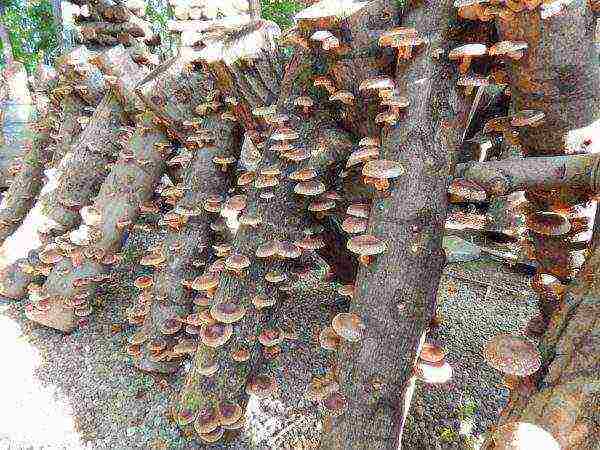 Growing mushrooms on stumps
Growing mushrooms on stumps
This environment is ideal for oyster mushrooms. In addition, the coffee grounds do not need to be sterilized again. The disadvantage of this method is that it is very difficult to get a large amount of freshly drunk cake at home. We'll have to ask him at the nearest cafe. The growing container can be regular freezer bags or ice cream containers.
The mycelium must be mixed with the cake, and then the container must be tightly closed. It can be stored under the sink. Germination time will be about 1 month. Once the surface is white, cut a small hole in the top of the bag. Through it, it is necessary to spray with water 2 times a day. After a week, you can see how small mushrooms begin to grow.
Growing porcini mushrooms and other species at home for beginners is a very exciting and useful activity. The needs of your family can be fully satisfied, even without special skills and large areas. The main thing is patience and a desire to see the result. After all, you can grow them all year round!
Growing mushrooms at home allows the owner not only to receive products for personal consumption, but also profit from the sale of natural, environmentally friendly mushrooms. Having chosen a suitable type of mushroom for growing, the owner will have to study in detail the process of preparing the area, the rules of care and harvesting.
The content of the article:
- Amazing mushrooms native to France
- How are truffles grown?
- Inoculation process
- Growth process
- Harvesting
- How is oyster mushroom grown?
- Growing with intensive technology
- Preparation of the substrate component
- Temperature treatment of the component
- Pasteurization of the substrate component
- The process of laying mycelium and growing oyster mushrooms
- Mushroom growth
- Collecting oyster mushrooms
- Extensive cultivation
- The process of growing mushrooms on stumps
- The process of growing mushrooms on wood
- Cultivation of porcini mushrooms
- Growing mushrooms using caps
- Growing mushrooms using ready-made mycelium
- Growing truffles, oyster mushrooms and porcini mushrooms: a successful business
Today everyone can grow mushrooms at home. Someone is engaged in such an exciting business in order to provide a family with a great delicacy. Some enterprising Russians have turned this occupation into a real lucrative business. What mushrooms do Russians grow at home today?
Amazing mushrooms native to France
Truffles are considered a gourmet delicacy all over the world. A kilogram of these unusual mushrooms can be fabulous. How are these amazing mushrooms grown? People have been trying to grow this type of mushroom for a long time. And they do this not only in order to make a profit, but to some extent in order to save this rare mushroom from extinction.
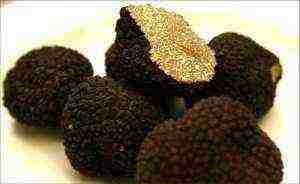
They learned about truffles at the end of the last century, when grape plantations began to die en masse in France, and so that the place would not stand idle, the owners of the vineyards decided to plant an oak grove in their place. They plowed the ground and planted acorns in it, as it turned out, later along with them they brought in the truffle mycelium.
Fifteen years later, when the young oak trees grew stronger, the farmers noticed unusual mushroom truffles under the oak trees and decided to try the curiosity at their own peril and risk. So, they learned about truffles, after which they began to cultivate it. The first mushrooms were grown and used for food in France.
Years later, they learned about truffles in Russia and also began to try to grow them, but so far only a few manage to do this: mushroom pickers have not yet reached the production level of truffle cultivation. But with oyster mushroom everything is much easier. This healthy and tasty mushroom has been grown for a long time not only at home, but also on farms. You will learn more about how mushrooms are grown at home below.
How are truffles grown?
In order to grow a truffle, it is necessary to infect the sprouts of oak or hazel with mushroom mycelium, after this procedure it is necessary to wait a couple of weeks, and only then place the seedlings in a quarantine room to maintain sterile and favorable conditions for growth.
Inoculation process
After the infection of young trees was carried out and they were kept in quarantine, mushroom pickers transplant them into the ground in a special nursery, which is kept in sterility and in completely quarantine conditions. If the conditions described above are not created, the truffles simply will not grow.
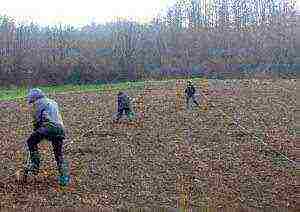
Growth process
After the young oak and hazel have been infected with truffle mycelium and planted in the ground, you need to be patient and observe the growth and development of fungi that are located in the root system of trees for a year.
Juveniles should be planted so that they rise no more than twenty centimeters above the ground. This is done so that the truffle can form a mycorrhiza in the roots of trees and subsequently successfully develop and bear fruit.
Young trees with truffles are recommended to be planted in spring, when frosts can no longer harm the plant and its root system. Truffles are very capricious, so they need to be grown in prepared black soil, completely free of weeds.
Planting trees must be guided by a 5x4 meter scheme. On one hectare, the number of trees should not exceed five hundred pieces.The truffle will grow and develop successfully only if the tree is planted to a depth of seventy-five centimeters. Thanks to this approach, frosts, pests and wind will not be able to harm mushrooms. If the radius reaches forty centimeters, then a thick layer of mulch must be poured around the seedling.
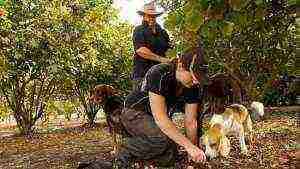
On the plantation where the truffle is planted, there should be no animals and pests. Also, from time to time, it is necessary to fertilize trees with NPK fertilizers. Also, trees must be fertilized with boron, iron, magnesium and zinc, thanks to these substances, the yield will increase significantly.
Harvesting
After a year, truffles can be harvested. For this, mushroom pickers use small shovels, with the help of which the mushrooms are removed from the ground.
How is oyster mushroom grown?
In order to grow oyster mushrooms, mushroom pickers use material containing cellulose. This can be wood, sawdust, straw, or paper. You can grow mushrooms in the country, at home and in specially prepared premises, as farmers do. In order for the yield to be good, the technology of growing oyster mushrooms is selected individually according to the capabilities and preferences of the mushroom picker. It can be extensive and intense.
The extensive method is suitable for summer residents who will grow oyster mushrooms in their natural environment on stumps or wood. The intensive method is suitable for indoor mushroom growers.
Growing with intensive technology
To grow mushrooms with this method in a special room, you need to maintain the microclimate necessary for the growth of mushrooms. If everything is observed according to the norms, the crop can be harvested four times a year.
Preparation of the substrate component
Before you start growing mushrooms, you need to prepare a substrate from cereals, straw or sunflower husks, mix it with grass flour, grind and heat treatment, then moisten. To do this, bags with a substrate component are filled with water and placed in prepared containers for a couple of days. To moisturize, you only need to use boiling water, in which the substrate component will remain for several days.
Temperature treatment of the component
After moistening, it must be treated with high temperatures so that the mycelium does not become infected with mold during the growth process. To carry out heat treatment, the substrate component must be heated to the desired temperature and kept in this state for sixty minutes.

Pasteurization of the substrate component
To carry out pasteurization processing, the substrate component is heated to sixty degrees, then it must cool to fifty, remaining in this state for eighteen hours. At the same time, good air circulation must be organized in a specially designated room where pasteurization is carried out. Over time, the substrate component is cooled to thirty degrees, after which it is ready for planting mycelium into it.
The process of laying mycelium and growing oyster mushrooms
The finished substrate component is mixed with the mycelium layer by layer and put into bags. After that, they are tied and wrapped in a film, in which holes are made for ventilation. The bags are stacked on the shelves and five days after they have been laid, with the support of the necessary microclimate, mycelium begins to appear.
When the mycelium is fully developed, it will mix with the substrate component to a dense homogeneous mass called a mushroom block.
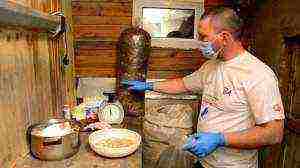
Mushroom growth
After the mushroom blocks have formed, they are transferred to a room with a certain microclimate and a constant flow of fresh air during fruiting. The first mushrooms will appear after ten to fifteen days.
Collecting oyster mushrooms
Oyster mushrooms ripen in clusters, and in order to harvest, they must be cut at the base so that the mycelium is not damaged.After pruning the mushrooms, a second crop will appear in fifteen days. When it is completely removed, the mushroom blocks are removed, and the room is disinfected and ventilated. After this procedure, you can start growing the next batch of oyster mushrooms. A similar cultivation technology can provide up to four harvests per year.
Extensive cultivation
Mushroom pickers include the cultivation of oyster mushrooms on wood and stumps as extensive methods.
The process of growing mushrooms on stumps
The tree stumps left over from the garden are ideal for growing mushrooms. In order to apply mycelium to the stump, it is necessary to cut off a layer of five centimeters from it, and then apply a two-centimeter layer of mycelium. Then the cut disc must be returned to its place and secured with nails. This procedure is best done in May. The first oyster mushrooms will appear in forty days. They will bear fruit three times before the onset of cold weather.
The process of growing mushrooms on wood
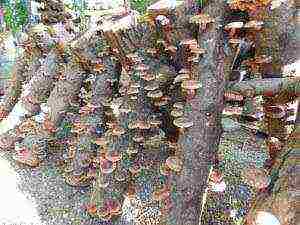
For this purpose, it is necessary to prepare in advance thirty-centimeter logs. Then soak them for forty-eight hours in water and then place them in the basement. This is best done in April. Further, the blocks must be placed in a column with a height of two meters. Apply mycelium to the top of it and cover with straw. If the required microclimate is observed, mycelium will begin to develop in two months.
When it gets warmer outside, the wood must be moved outside and buried in the ground by fifteen centimeters. The place where the mycelium is applied must be in the soil. After planting the logs, water the soil and wait for the first oyster mushrooms to appear.
Cultivation of porcini mushrooms
It is very difficult to grow porcini mushrooms, but it is still quite possible to grow them. This may seem like an impossible task for newcomers to the mushroom business, but if you try, you can cope with everything.
Growing mushrooms using caps
For this purpose, it is necessary to find mushrooms and separate the legs from the caps. Then you need to put the caps in a bucket and fill it with water mixed with a gram of manganese. Leave the mushrooms in the resulting solution for two hours, then add sugar to them (fifteen teaspoons per ten liters of water) and break the caps into small pieces, from which a new mycelium will form.
The resulting raw materials must be removed to the greenhouse before the mycelium appears. While the future mycelium is maturing, it is necessary to prepare the soil for planting. To do this, a ten centimeter layer of soil with a radius of about a meter is removed under the tree. Further, the roots of the tree are watered with the finished mycelium and buried in the ground. From time to time, the soil under the tree should be watered abundantly. After a while, the first mushrooms will begin to appear.
Growing mushrooms using ready-made mycelium
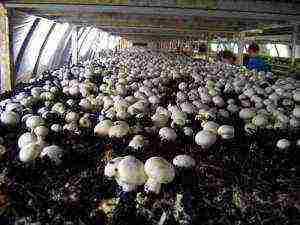
For the cultivation of porcini mushrooms, you can also use ready-made mycelium. To do this, it must be dug out in the forest and divided into pieces, folded into prepared holes under the trees in the country. Pour a three centimeters thick layer of forest soil on top and sprinkle with water. It remains only from time to time to water and wait for the harvest.
Growing truffles, oyster mushrooms and porcini mushrooms: a successful business
Since it is very difficult and unprofitable to grow truffles and porcini mushrooms, farmers are not involved in their cultivation. But innovator mushroom pickers are not averse to growing these rare varieties of mushrooms. Basically, they are cultivated in central Russia, and mushroom pickers do not want to spread too much about the recipes for their cultivation.
But oyster mushroom is grown and in industrial conditions there are many farms engaged in its cultivation. For example, they are engaged in breeding in Tula and Bashkortostan and Perm. Growing mushrooms is difficult, but very interesting, so be sure to try and believe me, you will definitely like it.
Every year, home growing of mushrooms is becoming more and more popular.Unfortunately, not all varieties of mushrooms can be bred in this way, some of them are too capricious to the surrounding conditions, others require serious financial investments. Based on this, before you start mushroom growing on your own, you need to find out what mushrooms are grown at home. Most often these are the following types:
- Champignons (all varieties), volvariella, ringlet, raincoat, dung beetle. These are soil fungi, usually they grow in fields or meadows in the humus layer of the soil.
- Porcini mushrooms, chanterelles, boletus, boletus, truffles, morels, mushrooms. These are mycorrhizal fungi that form a symbiosis with the roots of only certain trees. They are artificially grown from purchased mycelium (mycelium is sprouted mushroom spores that are placed in a substrate), but it is rather difficult to breed these types at home.
- Oyster mushroom (all types - common, royal, pink, lemon), honey mushrooms (winter, summer, poplar, marble), gericium, tinder fungus, shiitake. These types of fungi grow on the wood of dead trees or plant debris containing cellulose.
The most unpretentious of all and the easiest to grow at home are oyster mushrooms, shiitake, winter mushrooms, mushrooms and ringlet.
All of these species have certain requirements for the conditions of detention. It remains only to figure out which ones.
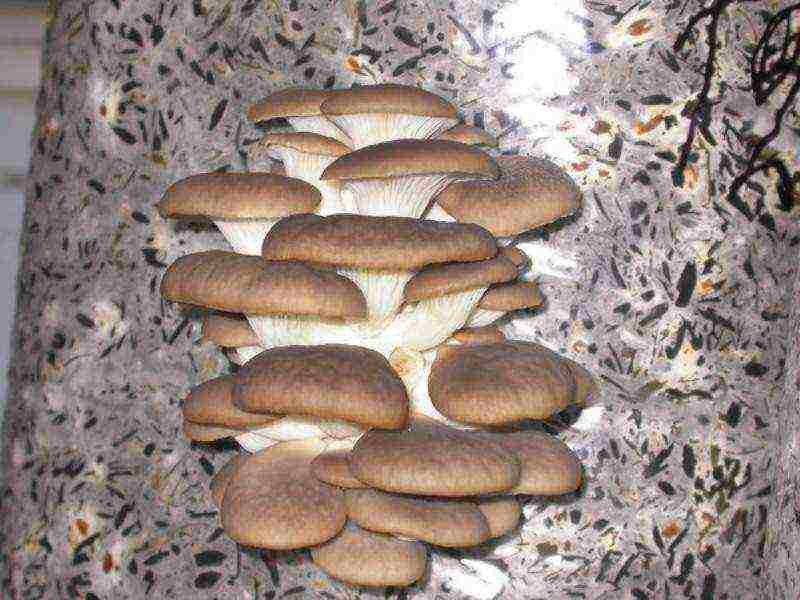 Oyster mushroom is in the first place in terms of prevalence and ease of cultivation. For novice mushroom growers, experienced entrepreneurs who have been engaged in mushroom growing for a long time suggest starting mushroom cultivation with it. When artificially growing oyster mushrooms, costs are required less than for all other mushrooms. Oyster mushroom is distinguished by unpretentiousness, excellent taste, early maturity, excellent yield, high resistance to viruses and bacteria, as well as rather long shelf life. Oyster mushrooms are grown in plastic bags (with a substrate, mushroom mycelium and bio-additives), on hemp, sawdust of various trees, straw, husk, corn stalks. Mushrooms grow well in rooms with a humidity of 80-85% and at fairly wide temperature ranges (from 10 to 30C, average values 16-20C). The first harvest of mushrooms can be cut after 30 days (in winter after 45). From one mushroom block at a time, it turns out to remove an average of 2.5-3 kg of crop. At the same time, serve 100 blocks on an area with an area of 30 sq. m. without problems even one person can. Mushrooms produce a harvest for 5 years.
Oyster mushroom is in the first place in terms of prevalence and ease of cultivation. For novice mushroom growers, experienced entrepreneurs who have been engaged in mushroom growing for a long time suggest starting mushroom cultivation with it. When artificially growing oyster mushrooms, costs are required less than for all other mushrooms. Oyster mushroom is distinguished by unpretentiousness, excellent taste, early maturity, excellent yield, high resistance to viruses and bacteria, as well as rather long shelf life. Oyster mushrooms are grown in plastic bags (with a substrate, mushroom mycelium and bio-additives), on hemp, sawdust of various trees, straw, husk, corn stalks. Mushrooms grow well in rooms with a humidity of 80-85% and at fairly wide temperature ranges (from 10 to 30C, average values 16-20C). The first harvest of mushrooms can be cut after 30 days (in winter after 45). From one mushroom block at a time, it turns out to remove an average of 2.5-3 kg of crop. At the same time, serve 100 blocks on an area with an area of 30 sq. m. without problems even one person can. Mushrooms produce a harvest for 5 years.- Champignons occupy the next place in the popularity of cultivation, both in an industrial economy and at home. They are much more demanding on the conditions of detention. And the technology of growing them is more expensive than breeding oyster mushrooms. Mushrooms are grown in bags or boxes with soil, in which the mycelium is laid. Champignons grow well in dark, cool rooms (12-18C, maximum value no more than 28C) with a humidity of 65-85%. The first harvest of mushrooms is ready for harvest in 45-50 days, and the next ones can be harvested within 3 months.
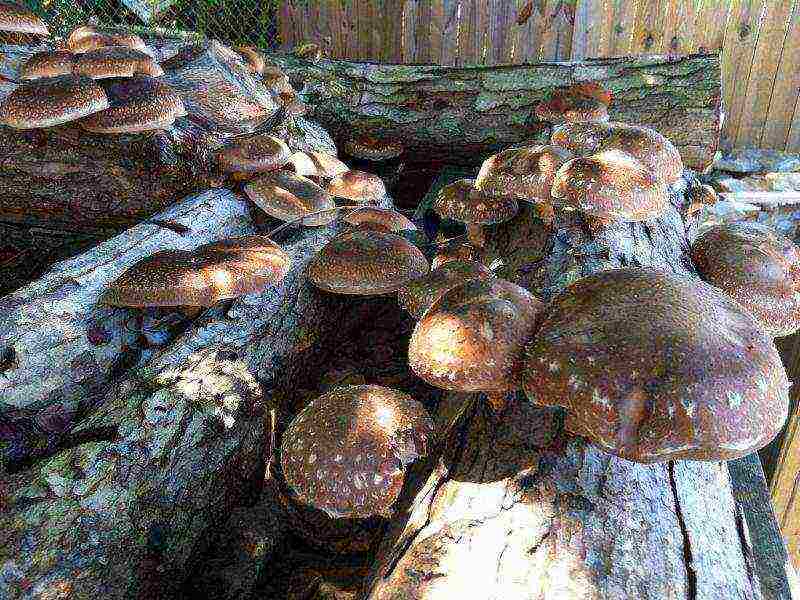 Shiitake - not only tasty, but also a very healing mushroom (it is successfully used in the treatment of cancer). Until a certain moment, it was grown only in Asian countries. Shiitake is one of the most expensive mushrooms (the price is about $ 50 per 1 kg). Grows well at an average temperature of 12C. It is grown on sections of wood and on various substrates. It is important to know that in order to get a harvest of really tasty and healthy shiitake, the mycelium for breeding must be purchased from Japan or China, but not European, because it is spoiled by selection. As a rule, the first harvest begins only in the next year and will last up to three years.
Shiitake - not only tasty, but also a very healing mushroom (it is successfully used in the treatment of cancer). Until a certain moment, it was grown only in Asian countries. Shiitake is one of the most expensive mushrooms (the price is about $ 50 per 1 kg). Grows well at an average temperature of 12C. It is grown on sections of wood and on various substrates. It is important to know that in order to get a harvest of really tasty and healthy shiitake, the mycelium for breeding must be purchased from Japan or China, but not European, because it is spoiled by selection. As a rule, the first harvest begins only in the next year and will last up to three years.- Winter honey - mushroom quite resistant to cold, grows well at an ambient temperature of 1-2 ° C. This mushroom has a pleasant taste and good nutritional value.It perfectly adapts to parasitizing on trees with living wood, and for this reason it should not be grown in backyard gardens or vegetable gardens, it is recommended to grow only on substrates and log cabins indoors.
- Koltsevik - not very well-known mushroom. Its cultivation began relatively recently, only about 25 years ago. This mushroom outwardly resembles a boletus, and in taste competes with champignons. It is grown on a personal plot directly on open ground beds or in plastic bags and boxes.
By becoming familiar with which mushrooms are grown at home, choosing a certain type for yourself and following the rules of caring for them, you will receive a constant tasty source of nutrients.
New in the rubric
The technology of growing mushrooms in the basement. What should be the premises? Choosing the best variety. Substrate preparation and planting. Further care.
Secrets of growing porcini mushrooms at home. How to prepare the seed yourself or buy the right mycelium? Mushroom picker tips for care.
Secrets of growing mushrooms in the country. Site selection and main methods: mycelium, mycelium and spores. Planting and caring for the crop. Features of harvesting.
Secrets of growing mushrooms as a business. Rules for registering your business. Required start-up capital. How to choose a room and equipment. Sales of finished products.
Is mushroom cultivation profitable as a business? Where to start and how to make a plan, how much money will it take? Harvesting and marketing of products. How to register a case?
The technology of growing mushrooms on stumps at home. Selection and preparation of stumps, rules for planting in the ground. Further care and harvesting.
Secrets of growing truffles at home. The choice of location and features of landing. Leaving and harvesting rules. Is it possible to do a mushroom business?
How to grow champignons in the country? How to prepare planting material? Site selection and preparation of the garden. Planting and further care. Features of harvesting.
How to make mycelium yourself at home? Growing technology and necessary conditions. Main types: grain and mushroom legs.
How to make your own oyster mushroom mycelium at home? Features of cultivation and step-by-step instructions in three stages. Next steps.
Growing oyster mushrooms at home for beginners. How to choose a place and mycelium. How to make the substrate yourself and form mushroom blocks. Features of care and harvesting.
Growing mushrooms seems too exotic and difficult to many. In fact, cultivated species - such as oyster mushroom or champignon - are relatively unpretentious to care for. You will have to tinker with forest mushrooms, and possibly go through several unsuccessful attempts, however, this task is quite feasible - you just need to know and follow a number of rules. How to prepare the substrate? How to make an infusion with spores or transfer mycelium from the forest? What place on the site is suitable for honey agarics or boletus? How to equip an oyster mushroom cellar? Read the articles of our authors and try your hand!
